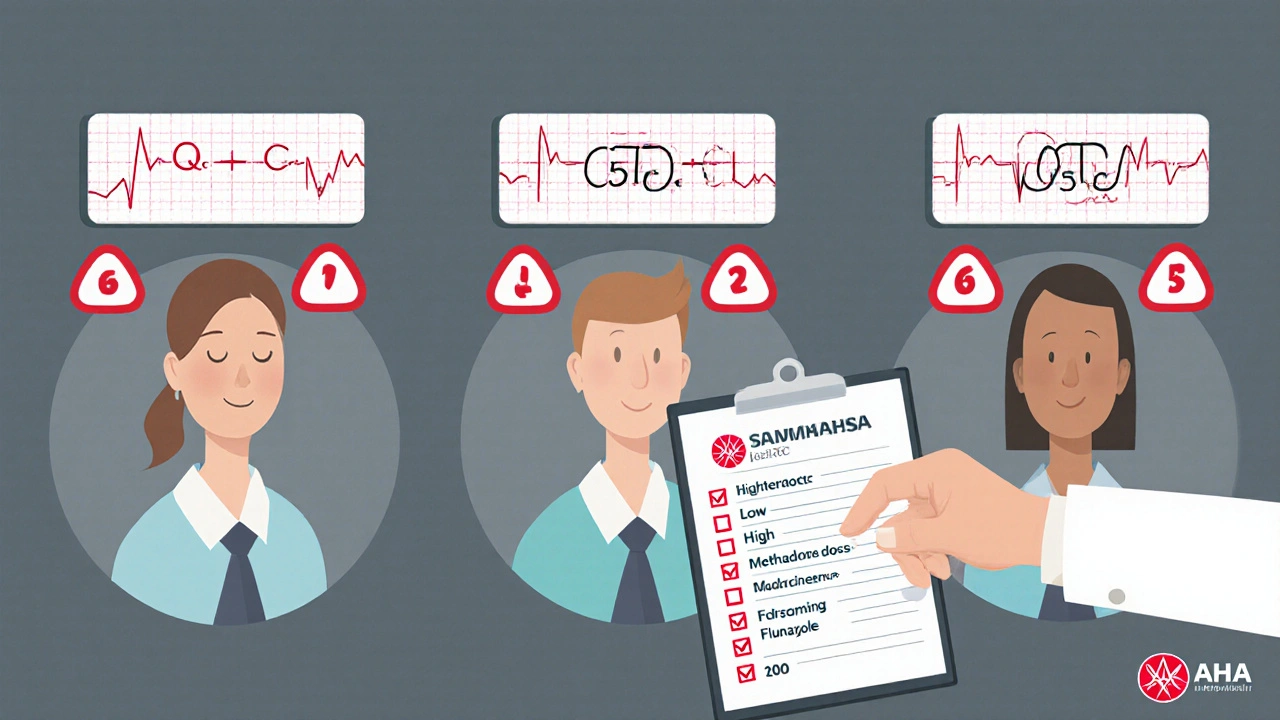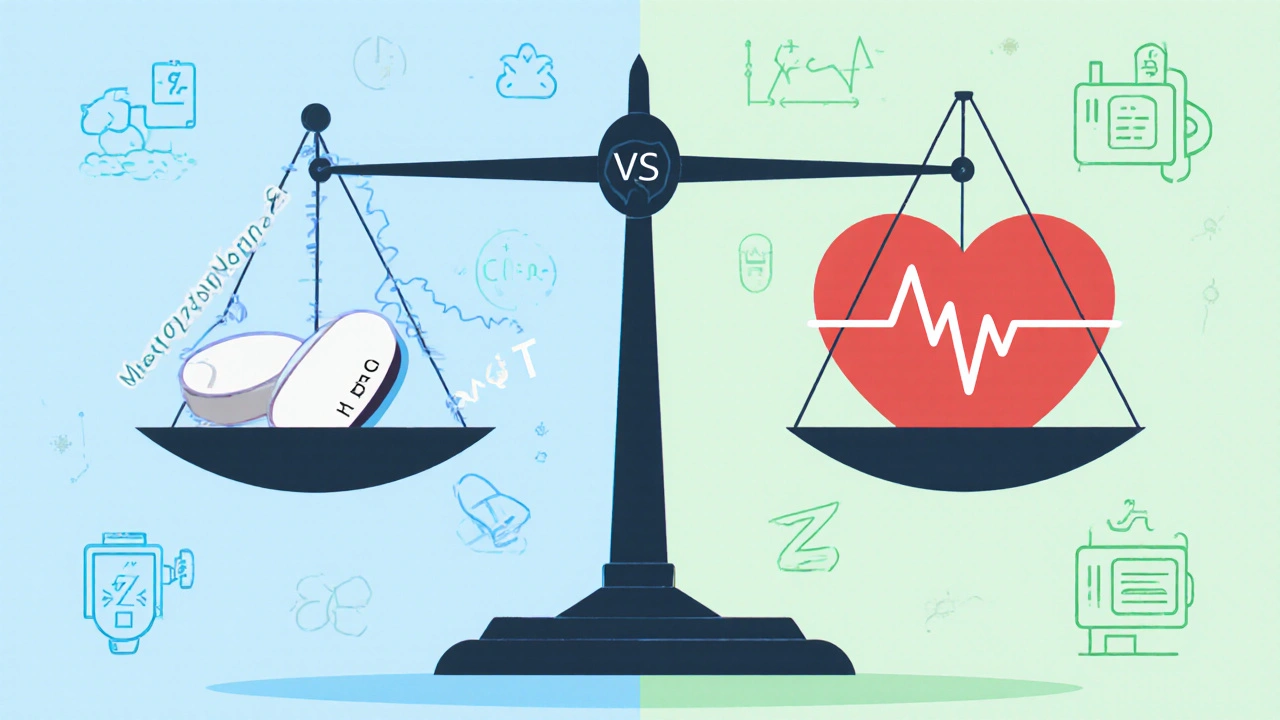Methadone and QT Prolongation: Essential ECG Monitoring Guidelines
 Nov, 16 2025
Nov, 16 2025
Methadone QT Prolongation Risk Calculator
Risk Assessment Tool
This tool calculates your risk of methadone-induced QT prolongation based on key clinical factors. The risk assessment helps determine recommended ECG monitoring frequency.
When someone starts methadone for opioid dependence, the focus is often on reducing cravings and preventing withdrawal. But there’s another hidden danger that many don’t talk about: methadone QT prolongation. This isn’t just a lab finding-it’s a real, potentially deadly risk that shows up on an ECG. And if you’re on methadone, especially at higher doses or with other health issues, you need to know what to watch for.
Why Methadone Can Slow Down Your Heart’s Electrical System
Methadone works by binding to opioid receptors in the brain, but it doesn’t stop there. It also blocks a specific potassium channel in the heart called hERG (KCNH2). This channel helps the heart reset after each beat. When it’s blocked, the heart takes longer to recover-this delay shows up on an ECG as a longer QT interval.
The QT interval measures how long it takes for the heart’s ventricles to charge and discharge. A normal QTc (corrected for heart rate) is under 430 ms for men and under 450 ms for women. Once it crosses 450 ms in men or 470 ms in women, you’re in the danger zone. At 500 ms or higher, the risk of a dangerous rhythm called Torsades de Pointes jumps dramatically. This isn’t theoretical. Between 2000 and 2022, the FDA logged 142 confirmed cases of Torsades linked to methadone. Many more likely went unreported because sudden death in people with opioid use disorder is often written off as overdose.
Who’s at Highest Risk?
Not everyone on methadone develops QT prolongation. But some people are far more vulnerable. The biggest red flags include:
- Daily methadone dose over 100 mg-risk triples compared to lower doses
- Female gender-women are 2.5 times more likely to develop QT prolongation
- Age over 65-aging hearts are less resilient to drug effects
- Low potassium (below 3.5 mmol/L) or low magnesium (below 1.5 mg/dL)-electrolytes keep the heart’s electrical system stable
- Heart problems like heart failure (ejection fraction under 40%) or prior heart attack
- Other QT-prolonging drugs: antidepressants like amitriptyline, antipsychotics like haloperidol, antibiotics like moxifloxacin
- Drugs that slow methadone metabolism: fluconazole, voriconazole, fluvoxamine-these can spike methadone levels by up to 50%
One study of 127 people in a Swiss hospital found that 28% had QTc over 450 ms. Of those, nearly 9% were above 500 ms. The strongest predictors? Dose over 100 mg, low potassium, and taking another psychiatric medication. These aren’t rare edge cases-they’re common in real-world methadone clinics.

When and How to Check Your QT Interval
ECG monitoring isn’t optional. It’s a basic safety step. Here’s what the guidelines say:
- Baseline ECG before starting methadone-even if you’re starting at 20 mg. Don’t skip this.
- Repeat ECG at steady state-usually 2 to 4 weeks after starting or changing your dose. Methadone builds up slowly in your system. The longest QT often shows up weeks later, not days.
- Follow-up based on risk:
- Low risk (QTc under 450 ms in men, under 470 ms in women, no other risk factors): every 6 months
- Moderate risk (QTc 450-480 ms in men, 470-500 ms in women, or 1-2 risk factors): every 3 months
- High risk (QTc over 480 ms in men, over 500 ms in women, or 3+ risk factors): monthly, plus consider switching to buprenorphine
If your QTc jumps more than 60 ms from baseline, or hits 500 ms or higher, you need immediate action: check electrolytes, reduce methadone dose, and talk to a cardiologist. Buprenorphine is a safer alternative for many people-it has minimal effect on the QT interval and is just as effective for opioid dependence.
What to Do If Your QTc Is Too Long
Don’t panic if your ECG shows a prolonged QT. But don’t ignore it either. Here’s what to do:
- Correct electrolytes-if potassium is low, take supplements. Same for magnesium. Even mild imbalances can push a borderline QT into danger.
- Review all your meds-list every pill you take, including over-the-counter drugs and supplements. Some cold medicines, antihistamines, and herbal products can also prolong QT.
- Lower your methadone dose-if you’re on 200 mg or more and have other risks, cutting back even 20-30 mg can make a big difference.
- Consider switching to buprenorphine-studies show it’s just as effective for reducing opioid use, with far less cardiac risk.
- Check for sleep apnea-about half of people on methadone have it. Sleep apnea causes oxygen drops that stress the heart and worsen arrhythmia risk. A simple sleep study can change your safety plan.
One 2023 study in JAMA Internal Medicine found that clinics with structured ECG monitoring programs cut serious cardiac events by 67%. That’s not a small benefit-it’s life-saving.

Why Many Clinics Still Get This Wrong
Despite clear guidelines from SAMHSA, the American Heart Association, and the FDA, many methadone clinics don’t follow them. A Reddit survey of 142 people in recovery found that 68% said ECG monitoring was inconsistent or nonexistent at their clinic. Some only did one ECG at intake. Others didn’t do any.
Patients who got regular monitoring reported feeling safer and more confident in their treatment. Those who didn’t often worried about sudden death and avoided asking for tests out of fear they’d be labeled “noncompliant.” This gap between guidelines and practice is dangerous. Methadone saves lives-but without proper monitoring, it can end them.
Bottom Line: Don’t Assume You’re Safe
Methadone is a powerful tool for recovery. But it’s not harmless. The same dose that helps you stay off heroin can also mess with your heart’s rhythm. The key is not avoiding methadone-it’s managing the risk.
If you’re on methadone:
- Get a baseline ECG before you start
- Get another one 2-4 weeks later
- Ask your provider: “What’s my QTc? Is it safe for my dose and other meds?”
- If you’re on high doses or have heart issues, insist on regular monitoring
- If your QTc is high, don’t wait-ask about lowering your dose or switching to buprenorphine
Sudden cardiac death from methadone isn’t common-but it’s preventable. And if you’re taking it, you deserve to know how to stay safe.
Can methadone cause sudden death even if I don’t overdose?
Yes. Methadone can trigger a dangerous heart rhythm called Torsades de Pointes, which can lead to sudden cardiac arrest-even if you haven’t taken too much. This risk is tied to QT prolongation, not overdose. Many deaths in people on methadone are misclassified as overdose when they’re actually arrhythmias.
How often should I get an ECG if I’m on methadone?
It depends on your risk level. Low-risk patients (normal QTc, no other issues) need an ECG every 6 months. Moderate-risk (mild QT prolongation or one risk factor) need one every 3 months. High-risk patients (QTc over 480 ms in men or 500 ms in women, or multiple risk factors) need monthly ECGs and should consider switching to buprenorphine.
Is buprenorphine safer than methadone for my heart?
Yes. Buprenorphine has minimal effect on the QT interval and is not linked to Torsades de Pointes in the same way methadone is. Studies show it’s just as effective for treating opioid dependence. If you have risk factors for QT prolongation, switching to buprenorphine is often the safest choice.
Can low potassium make methadone more dangerous?
Absolutely. Low potassium (below 3.5 mmol/L) is one of the strongest predictors of QT prolongation in people on methadone. Even mild low potassium can push a borderline QT into dangerous territory. Regular blood tests and potassium supplements, if needed, are critical.
Should I get an ECG if I’m on less than 100 mg of methadone?
Yes-if you have other risk factors. Even low doses can prolong QT in women, older adults, or people with heart disease or electrolyte imbalances. Guidelines say baseline ECG is recommended for everyone starting methadone, regardless of dose. Don’t assume low dose = no risk.
What if my clinic won’t do regular ECGs?
Request a referral to a cardiologist or your primary care provider. ECGs are simple, quick, and often covered by insurance. If your clinic refuses, ask for written guidelines from SAMHSA or the American Heart Association. Your safety matters more than clinic policy. If needed, you can get a standalone ECG at an urgent care center or hospital.
Can I still take methadone if my QTc is high?
It’s possible, but only with strict monitoring and risk reduction. If your QTc is over 480 ms (men) or 500 ms (women), your provider should reduce your dose, correct electrolytes, stop other QT-prolonging drugs, and monitor you monthly. If QTc stays high despite these steps, switching to buprenorphine is the safest long-term option.